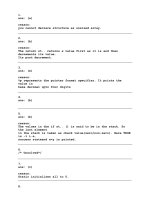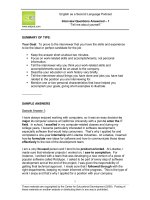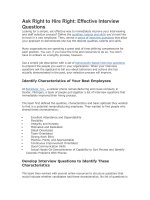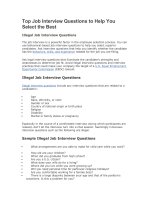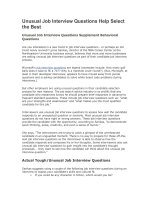Quick javascript interview questions learn frequently asked question
Bạn đang xem bản rút gọn của tài liệu. Xem và tải ngay bản đầy đủ của tài liệu tại đây (4.36 MB, 90 trang )
QuickJavaScriptInterviewQuestions
CopyrightBlurb
Allrightsreserved.Nopartofthisbookmaybereproducedinanyformorbyany
electronicormechanicalmeansincludinginformationstorageandretrievalsystems–
exceptinthecaseofbriefquotationsinarticlesorreviews–withoutthepermissionin
writingfromitspublisher,SandeepKumarPatel.
Allbrandnamesandproductnamesusedinthisbookaretrademarks,registered
trademarks,ortradenamesoftheirrespectiveholders.Iamnotassociatedwithany
productorvendorinthisbook.
PublishedBy
SandeepKumarPatel.
TableofContents
QuickJavaScriptInterviewQuestionsTableofContents
Chapter1Inheritance
Chapter2QuestionsonEvent
Chapter3Closure
Chapter5QuestionsonDOM
Chapter6DateObject
Chapter7RegularExpression
Chapter8QuestionsonCanvasAPIChapter9GeoLocationAPI
Chapter10WebWorkers
Chapter11LocalStorage
Chapter12FileAPI
Chapter13WebRTC
Chapter14Drag&DropAPI
Chapter15AppCacheAPI
Chapter16ServerSentEventsChapter17MiscellaneousQuestionsAboutThe
Author
OneLastThing…
Chapter1Inheritance
Q.Howtocreateaclass?
ANSWER
JavaScriptdoesnothaveaclassdefinition.TomimicclassesinJavaScriptfunctionscan
beusedtodeclareaclass.
Example:
Let’screateastudentclassinJavaScriptwhichtakestwoparametersnameandrollas
property.Thecodewilllooklikebelow,
functionStudent(name,roll){this.name=name;
this.roll=roll;
}
Q.Howtocreateanobject?
ANSWER
AnobjectinJavaScriptcanbecreatedusingtwoways:
NewKeyword:
TocreateastudentobjectfromtheabovestudentclasswecancalltheStudentfunction
usingnewkeyword.
varstudent1=newStudent(‘sandeep’,2)
AnonymousObject:
Anonymousobjectscanbecreatedusingpairofcurlybracescontainingpropertyname
andvaluepairs.
Varrose={‘color’:’red’}
Q.Howtodeclareaprivateandapublicmember?
Privatemembersaredeclaredusingvarkeywordandconstructorfunction.
functionStudent(name,roll){varid=ABCD123;
this.name=name;
this.roll=roll;
}
WhenaStudentobjectwillbecreatedthepropertiednameandrollwillbeaccessible
usingdotoperatorbutidwillnotbeaccessibleasitbehavesasaprivatememberand
returnundefinedoncall.
Theabovechromeconsoleisshowingastudent1objectiscreated.namepropertyis
accessibleasitisshowingsandeeponstudent1.namecall.Sonameisapublicpropertyfor
thestudentobject.Butidpropertyisnotaccessibleandreturnedundefinedonstudent1.id
call.Thisshowsidisaprivatepropertyinstudent1object.
Q.Whatisprototypeproperty?
ByUsingPrototypewecanaddnewmemberstoanexistingobject.EveryJavaScript
objecthasthispropertyinternally.Initiallyitisanemptyobject.
Example:
functionStudent(name,roll){
this.name=name;
this.roll=roll;
}
varstudent1=newStudent(‘sangeeta’,30);Student.prototype.mark=100;
Checkoutthebelowchromeconsolefortheuseofprotype.
Initiallythestudent1objecthasonlytwopropertiesnameandroll.Byusingprototypea
newpropertymarkhasbeenaddedtostudentobjectwithavalueof100.Nowtheconsole
showsthatthemarkpropertyisalsoaddedtotheexistingstudent1object.
Q.Whatisconstructorproperty?
ANSWER
Constructorpropertyofanobjectmaintainsareferencetoitscreatorfunction.
Example:
Letuscheckoutanexamplebycreatingastudentobjectandcallingtheconstructor
propertyonit.
functionStudent(name,mark){
this.name=name;
this.mark=mark;
}
varstudent1=newStudent(‘sandeep’,123);console.log(student1.constructor);
Checkoutthefollowingscreenshotforabovecodeinchromeconsole.Theconsolelogis
printingthereferencedfunctionbystudent1object.
Q.Howtocallotherclassmethods?
ANSWER
Usingcall()andapply()methodwecanusemethodsfromdifferentcontexttothecurrent
context.Itisreallyhelpfulinreusabilityofcodeandcontextbinding.
call():Itisusedtocallsafunctionwithagiventhisvalueandargumentsprovided
individually.
apply():Itisusedtocallafunctionwithagiventhisvalueandargumentsprovidedasan
array.
BelowcodehastwofunctiongetTypeOfNumber()andgetTypeOfAllNumber().The
detailspfthesefunctionsarebelow.getTypeOfNumber:Thismethodtakessingle
numberas
parameterandreturnthetypeeitherEvenorOdd.
getTypeOfAllNumber:Thismethodtakesarrayofnumbers
asparameterandreturnthetypesinanarraywithEvenor
Odd.
varMyNumber={
getTypeOfNumber:function(number){
vartype=(number%2===0)?“Even”:“Odd”;returntype;
},
getTypeOfAllNumber:function(){
varresult=[],i=0;
for(;i
MyNumber.getTypeOfNumber.call(null,arguments[i]);
result.push(type)
}
returnresult;
}
};
vartypeOfNumber=
MyNumber.getTypeOfNumber.call(null,21)console.log(typeOfNumber)
vartypeOfAllNumber=
MyNumber.getTypeOfAllNumber.apply(null,[2,4,5,78,21])
console.log(typeOfAllNumber)
BelowscreenshotshowsoutputoftheabovecodeFirebugconsole.
Q.ExplainmethodoverridingwithanExample?
ANSWER
WecanoverrideanyinbuiltmethodofJavaScriptbydeclaringitsdefinitionagain.The
existingdefinitionisaccessibletooverridebytheprototypeproperty.Considerthebelow
example,split()isanbuilt-inmethodforastringobject.Itsdefaultbehaviourtobreakthe
specifiedstringtoanarrayandisamemberfunctionofStringclass.Butwehave
overriddenitsdefinitionusingitsprototypeproperty.
Belowscreenshotshowstheinbuiltbehaviourofsplit()method.Ithasdividedthestring
intoanarrayofelement.
Thefollowingscreenshotshowsthenewoverriddendefinitionofsplit()method.Itisnow
normallyreturnsstring“Iamoverriden”.
Q.Howtoinheritfromaclass?
ANSWER
InheritancecanbeachievedinJavaScriptusingprototypeproperty.
Weneedtofollow2stepstocreateaninheritance.
Step1:
Childclassprototypeshouldpointtoparentclassobject.
<ChildClassName>.prototype=new<ParentClass>();
Step2:
Resetthechildclassprototypeconstructortopointself.
<ChildClassName>.prototype.constructor=<ChildClassName>
Example:
BelowexampleshowsScienceStudentclassasachildclassofStudentclass.Asthe
methodshowMyType()isavailableforScienceStudentobject.
functionStudent(name){
this.name=name;
}
Student.prototype.sayMyType=function(){
console.log(“Iamstudenttype”)
}
functionScienceStudent(name){
}
ScienceStudent.prototype=newStudent();
ScienceStudent.prototype.constructor=ScienceStudent;
varstudent2=newScienceStudent(‘sangeeta’);
console.log(student2.sayMyType());
Checkoutthebelowscreenshotfortheoutputoftheabovecodeinthedeveloperconsole.
TotestthetypeofanobjectbelongstoaclassornotinstanceOfcanbeused.Thisreturns
aBooleanvalue,TRUEforanobjectbelongstoaclassorelseFALSE.Checkthebelow
screenshotforthetestofstudent2objectusinginstanceOf.
Q.Whatisdifferentialinheritance?
ANSWER
DifferentialInheritanceisacommonprototype-orientedmodelthatusestheconceptthat
mostobjectsarederivedfromother,moregenericobjects,andonlydifferinafewsmall
aspects.Eachobjectmaintainsareferencetoitsprototypeandatableofpropertiesthatare
different.
Q.WhatisObject.create()methoddo?
ANSWER
ECMAScript5.1hasthismethodinitsspecification.Thismethodcanbeusedtocreatea
newobjectwithgivenprototypeobjectandproperties.Thesyntaxofthismethodislisted
below.
Object.create(proto[,propertiesObject])
Example:
BelowcodehasaStudentclassfunctionwithnamepropertyandtheprototypeobjecthas
amethodgetStudentName()whichreturnthenameofthestudent.Anewstudent1objecthas
beencreatesusingObject.create()methodbypassingtheprototypeobjectofStudentwith
valueofthenameassandeep.ThenthegetStudentName()methodiscalledonstudent1object
andloggedintheconsole.
functionStudent(name){
this.name=name;
}
Student.prototype={
getStudentName:function(){
return“NameofStudentis:”+this.name;}
};
varstudent1=Object.create(Student.prototype);student1.name=“Sandeep”;
console.log(student1.getStudentName());
Thefollowingscreenshotshowstheoutputoftheabovecodeinthedeveloperconsole.
Q.WriteapolyfillforObject.create()methodifitisnotpresentinthebrowser?
ANSWER
ECMAScript5.1hasthismethodinitsspecification.IfthebrowserisoldthenObject.create()
methodisnotpresent.Toresolvethisweneedtowriteapolyfill.Belowcodeshowsthe
polyfillforObject.create()method.
//checkifcreatemethodispresentinsideObjectif(typeofObject.create!=‘function’){
//definethecreatemethod
Object.create=(function(){
varObject=function(){};
returnfunction(prototype){
if(arguments.length>1){
throwError(‘Secondargumentnotsupported’);
}
if(typeofprototype!=‘object’){
throwTypeError(‘Argumentmustbeanobject’);
}
Object.prototype=prototype;
varresult=newObject();
Object.prototype=null;
returnresult;};
})();
}
Theabovecodechecksifthecreate()methodisalreadypresentinsidetheObjectusingif
conditionandcomparingitstypetofunction.Ifthisconditiontrueitmeansthecreate()
methodisnotpresent.Thenthepolyfillcodeblockgetsexecutesandassignstheempty
objecttoObject.createproperty.
Q.WhatisthepurposeofObject.defineProperties()method?ANSWER
ECMAScript5.1providesObject.defineProperties()methodtocreatenewpropertiestoa
definedobject.Itprovidesmanyconfigurationoptionstoinitializethesemembers.Below
codeshowstheuseofthismethod.
functionStudent(name){
this.name=name;
}
varstudent1=Object.create(Student.prototype),
properties={
“subject”:{
value:“Computer”,
writable:true,
enumerable:true
},
“marks”:{
value:0,
writable:false,
enumerable:true
}
};
Object.defineProperties(student1,properties);
student1.name=“Sandeep”;
student1.subject=“Mathematics”;
student1.marks=75;
console.log(student1);
Intheabovecodeastudent1objectcreatedusingObject.create()method.Thensomenew
propertieslikesubjectandmarksareaddedtothisobject.Theenumerableoptiondecided
whetherthepropertycanbeenumeratedasownproperty.Writablepropertydecideswhether
thepropertyismodifiableornot.Thevaluepropertytakesthedefaultvalueoftheproperty.
Belowscreenshotshowstheoutputoftheabovecodeinthedeveloperconsole.
Q.HowcanyoudistinguishscopeandcontextinJavaScript?ANSWER
Scopepertainstothevisibilityofvariablesandcontextreferstotheobjecttowhicha
methodbelongsandcanbechangedbyusingcallorapplies.
Q.Whataretwowaysinwhichthevariablecanbeassignedtoanemptyobject?
ANSWER
Whencreatinganewemptyobject,youcaninstantiatetheObject()constructororyoucan
simplycreateanemptyobjectliteral.Ineithercase,youcanthenaddpropertiestothe
newobject.Thesyntaxofcreatingemptyobjectislistedbelow.
varaEmptyObject=newObject();
varaEmptyObject=={};
Chapter2QuestionsonEvent
Q.HowEventworks?
ANSWER
Eventpropagationfollowstwophasescapturingandbubblingphase.
CapturingPhase:
Inthisphase,eventfirstmakesitswaydownwardsfromtheDOCUMENTtothetarget
elementbypassingallinnerelements.
BubblingPhase:
Inthisphaseeventmakesitswaybackupwardsfromthetargetelementto
DOCUMENTbypassingallouterwrappedelements.
Q.Howtoattacheventtoanelement?
ANSWER
AccordingtoDOMLevel2EventSpecificationaneventcanbeattachedtoanelement
usingaddEventListener()methodusingthreearguments.
Syntax:
<element>.addEventListener(<eventname>,<eventcallback>,<booleanphase>)
eventname:
RepresentstypeofeventasStringparameter.ForExampleclick,mouseover,mouseout
etc.
eventcallback:
Thisrepresentsthecallbackfunctiontobecalledfortheeventtobehandled.
booleanphase:
Thisrepresentsthephaseoftheeventwherethelistenerisattached.AFALSEvalue
representsthebubblingphaseandaTRUEvaluerepresentsacapturingphase.
Example:
Aclickeventlistenerisaddedtothedocumentwhichalertsamessagewhenclickoccur.
document.addEventListener(‘click’,function(){alert(“InsiderEventListener”);
},false);
Q.HowtoattacheventpriortoIE9browserversion?ANSWER
InIEolderbowseraneventcanbeattachedtoanelementusingattachEvent()method.
OnlyForbubblingphasealistenercanbeadded.
Syntax:
<element>.attachEvent(<eventname>,<eventcallback>)
Example:
Aclickeventlistenerisaddedtothedocumentwhichalertsamessagewhenclickoccur.
BelowscreenshotshowsaddingaclickeventinIE10developertoolbar.
ExceptIE,theotherbrowseraddedbyaddEventListener()method.Belowscreenshot
showsthedemonstrationthismethodinFirebug.
Q.Howtoremoveeventlistener?
ANSWER
AccordingtoDOMLevel2EventSpecificationanEventListenercanberemovedusing
removeEventListener()method.ForIEbrowsersdetachEvent()methodmustbeused.
ThefollowingscreenshotshowsdetachingclickeventhandlerfromdocumentforIE
browser.
ThefollowingscreenshotshowsremovingclickeventhandlerfromdocumentforFirefox
browser.
Q.HowsetTimeOut()andclearTimeOut()functionworks?ANSWER
ThesetTimeout()methodcallsafunctionorevaluatesanexpressiononceaftera
specifiednumberofmilliseconds.clearTimeOut()methodstoptheexecutionofthe
functionspecifiedinthesetTimeout()method.
Syntax:
vartimeOut=setTimeout(function,milliseconds,lang)clearTimeout(timeOut)
Belowcodeshowsthedemonstrationofthesetimeoutmethods.
vartimeOutHandler=function(){
console.log(“insideTimeNow“,newDate().getSeconds());clearTimeout(timeOut)
}
console.log(“TimeNow“,newDate().getSeconds());vartimeOut=
setTimeout(timeOutHandler,4000);
BelowscreenshotshowtheexecutionofthetimeOutHandler()methodafter4seconds.
Q.HowsetInterval()andclearInterval()functionworks?ANSWER
ThesetInterval()methodcallsafunctionorevaluatesanexpressioninspecifiedinterval
ofmilliseconds.clearInterval()methodstoptheexecutionofthefunctionspecifiedinthe
setInterval()method.
Syntax:
vartimeInterval=setInterval(function,milliseconds)clearInterval(timeInterval)
Belowcodedemonstratetheseintervalhandlers.
varcounter=0,
timeIntervaltHandler=function(){
console.log(“insideTimeNow“,newDate().getSeconds());counter++;
console.log(“HandlerCalledcount“,counter)
if(counter===4){
clearInterval(timeInterval);
console.log(“Clearingtheintervalhandler”)
}
}
console.log(“TimeNow“,newDate().getSeconds());vartimeInterval=
setInterval(timeIntervaltHandler,2000);
Belowscreenshotshowsthehandlercalledevery2secondfor4times.After4thcalled
clearInterval()removetheexecution.
Chapter3Closure
Q.WhatisClosure?
ANSWER
Aclosureisaninnerfunctionthathasaccesstotheouterwrappedfunction’svariables.It
hasthreedifferentscopeaccesses:-Self-scope:
Ithasaccesstopropertiespresentinitsownscope.
Wrappedfunction’sscope:
Ithasaccesstothepropertiespresenttofromitsenclosingfunction.
GlobalScope:
Ithasaccesstothepropertiespresentinglobalscopethatiswindowscope.
Example:
Theinnerfunctionstillhastheaccesstoprop1thoughprop1belongstoouterfunction
scope.
functionmyOuterFunction(){varprop1=5;
returnfunctioninnerFunction(){
returnprop1;
}
}
varres=myOuterFunction();console.log(res.name);
console.log(res());
Belowscreenshotshowstheoutputoftheabovecodeintheconsole.
Q.Giveanexampleofpracticalimplicationofclosureconcept?ANSWER
Inwebpagedevelopmentclosuresaremorefrequentlyusedbythedevelopers.Amost
commonscenarioiswhenweneedsomekindoffactorywhichwillreturnafunction
objectwithdifferentvaluethatcanbeusedbyapplication.
Example:
ThefollowingcodehasabackgroundcolorfactorynamedbackgroundColorFactorywhich
returnsafunctionwithaninputcolor.UsingthisfactorywehavecreatedgreenBackground
andblueBackgroundfunctionobjectsandbindedwiththe2buttons.Onceuserclicksthese
buttonsthebackgroundcolorofthebodyischangedtothetargetedcolor.
<!DOCTYPEhtml>
<html>
<head>
<metacharset=“utf-8”>
<title>PracticalClosureExample</title>
</head>
<body>
<buttonid=“greenButton”>GreenBackground</button><buttonid=“blueButton”>Blue
Background</button><script>
varbackgroundColorFactory=function(color){returnfunction(){
document.body.style.background=color;};
};
vargreenBackground=backgroundColorFactory(‘green’);varblueBackground=
backgroundColorFactory(‘blue’);
document.getElementById(‘greenButton’).onclick=greenBackground;
document.getElementById(‘blueButton’).onclick=blueBackground;
</script>
</body>
</html>
Theoutputoftheabovecodeislistedinbelowscreenshot.
Q.Emulatetheprivatedatausingclosure?
ANSWER
Thefollowingcodedemonstratesthedeclarationofprivatevariable_name.Itmeanswe
canassignthe_namevalueusingStudentconstructorwithanewkeyword.
functionStudent(name){var_name=name;
this.getName=function(){return_name;
};
}
varstudent1=newStudent(“Sandeep”);student1._name=“John”;
console.log(student1.getName());
Thedetailsofthepreviouscodeareasfollows:
AStudentobjectstudent1iscreatedwith_namehasvalueSandeep.
AnewnamevalueJohnisassignedto_namebutthegetName()methodprintsSandeep
totheconsole.Itproves_nameisprivate.
ThefollowingscreenshotshowstheChromeconsolewiththeoutputofthepreviouscode.
Chapter4QuestionsonJSON
Q.WhatisJSON?
ANSWER
TheJSONtextformatissyntacticallyidenticaltothecodeforcreatingJavaScriptobjects.
JSONisonlyasubsetofJSobjectliteralnotation,butapartfromlookingsimilar,they
havenothingincommon.JSONisusedasdataexchangeformat,likeXML.JSONisbuilt
ontwostructures:
Acollectionofname/valuepairs.Invariouslanguages,thisisrealizedasanobject,record,
struct,dictionary,hashtable,keyedlist,orassociativearray.
Anorderedlistofvalues.Inmostlanguages,thisisrealizedasanarray,vector,list,or
sequence.
Q.WhydoesGoogleprependwhile(1);totheirJSONresponses?ANSWER
ItpreventsJSONhijacking.Thisistoensuresomeothersitecan’tdonastytrickstotryto
stealdata.Byreplacingthearrayconstructor,thenincludingthisJSONURLviaa<script>
tag,amaliciousthirdpartysitecouldstealthedatafromtheJSONresponse.Byputtinga
while(1);atthestart,thescriptwillcrashinstead.Asame-siterequestusingXHRanda
separateJSONparser,ontheotherhand,caneasilyignorethewhile(1);prefix.
Q.WhatisJSONP?
ANSWER
JSONPstandsfor“JSONwithPadding”.ItmeansJSONdatawrappedinafunctioncall.
Acallback(processing/padding)functionalreadydefinedintheWebpageatthetimeof
requestingremoteJSONdata.
Example:
ThebelowJavaScriptcodeshowsacallbackfunctionpaddingFunction()foraremoteURL
//abcdurl.
functionpaddingFunction(data){
console.log(“responsedataprocessingcode”)
}
varscript=document.createElement(‘script’);
script.src=‘//abcdurl?callback=paddingFunction’
document.getElementsByTagName(‘head’)[0].appendChild(script);
Q.WhyuseJSONoverXML?
ANSWER
ThefollowingpointsareinfavorofJSONoverXMLformat:
JSONcancontainInteger,String,List,Arrays.XMLisjustnodesandelementsthatneeds
tobeparsedintoInteger,Stringandsoonbeforeitisusedbyyourapplication.JSONis
smaller,fasterandlightweightcomparedtoXML.Sofordatadeliverybetweenservers
andbrowsers,JSONisabetterchoice.
JSONisbestforuseofdatainwebapplicationsfromwebservicesbecauseofJavaScript
whichsupportsJSON.TheoverheadofparsingXMLnodesismorecomparetoaquick
lookupinJSON.
Foranewbie,JSONmightlookcomplextoreadandunderstandbecauseofitsstructure


